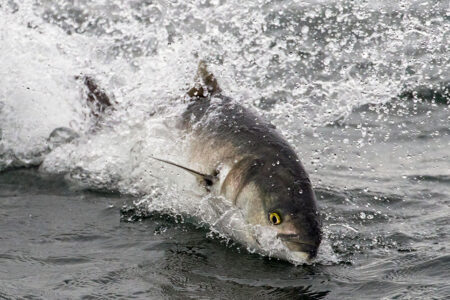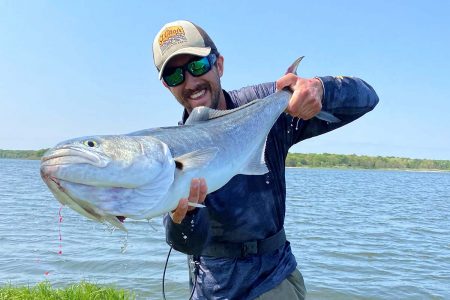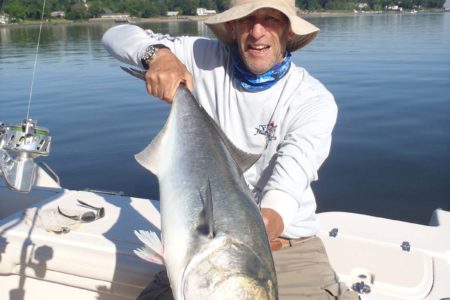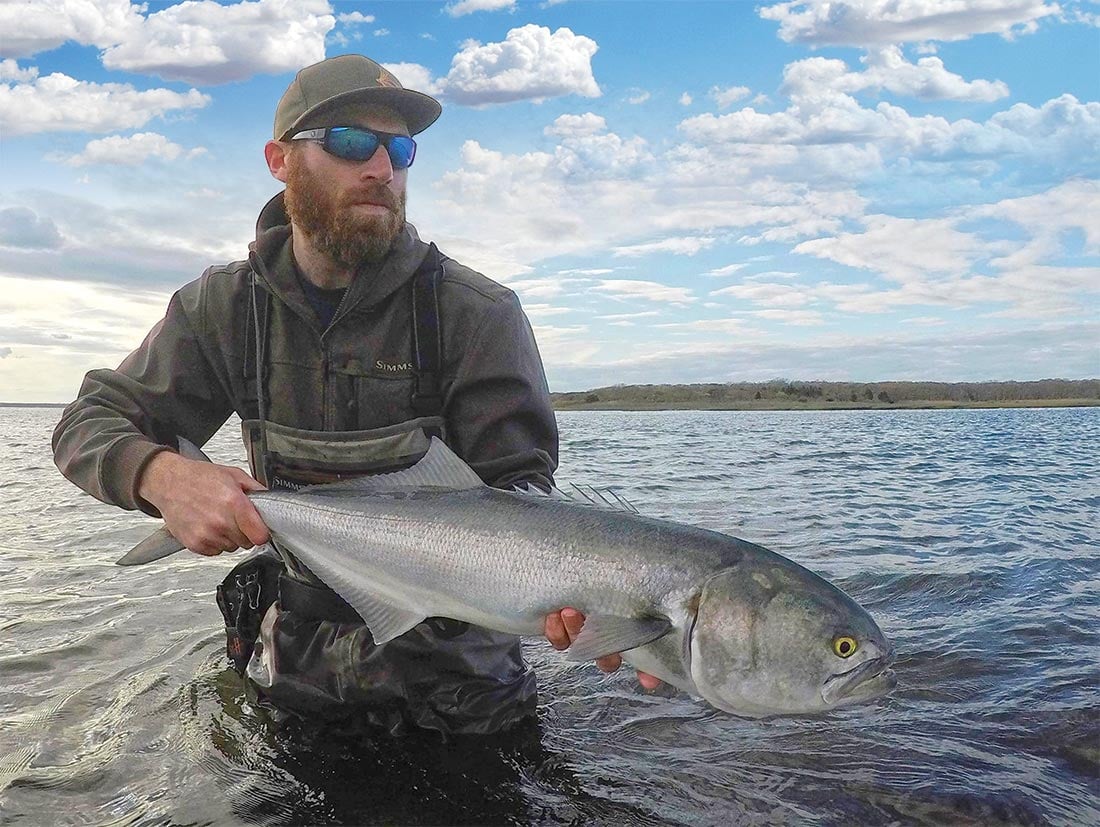
There’s nothing more exciting than working a popper for blues, whether from boat or shore, anticipating that the next cast will result in an explosive surface strike.
Everyone is singing the blues this year, or at least looking at our beloved bluefish in a different light, thanks to our new coastwide regulations. Many of us remember no bag limit on blues. Many more have fished under a generous 15 fish bag limit, and now 2020 will go down in the annals of fishery management as the recreational bag limit reduction of three per person, five on a party/charter boat. Wow, that’s some cut! At least there’s no size or slot limit to muddy the regulation waters, but even that bit of relief will be no help to snapper fans. Three snappers certainly won’t fill the baitwell or fish fryer, and while many anglers may not agree with the new regulations, we’ll learn to live with them, just as we have all of the other regulations since the Magnuson Act of 1976. Over 20 years ago, the Mid-Atlantic Fishery Management Council established a 15 fish bag limit as a baseline for management of Pomatomus saltatrix, aka bluefish. As a member of that Council back then, I viewed the generous bag limit as a visionary regulation. We were carving out a healthy slice of the bluefish pie for recreational fishermen for generations to come. Bluefish were abundant, and the commercial market was limited. Time and fishing seasons will tell if this latest law is draconian or once again visionary.
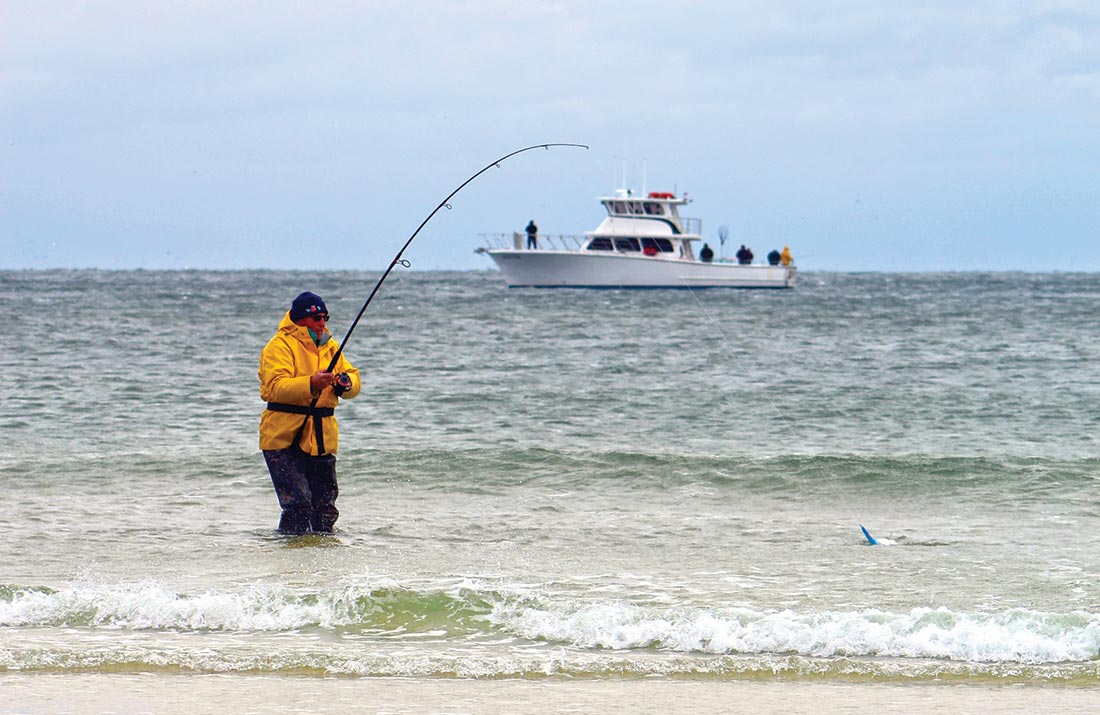
Bluefish were, and still are, one of the stalwarts of our saltwater fishing community. And the fishery is still relatively healthy, albeit spotty, from one season to the next. We’ll adjust to the new regulations, many albeit grudgingly, because it’s the law. Fortunately, the catch and release ethic so common in today’s angling culture makes this latest reg a bit easier to swallow. We will continue to have fun pursuing one our favorite gamefish. As an unabashed fan and promoter of bluefish, I’m going to have another great season. I also hear a big collective yawn from a contingent of our recreational community, a “who cares, bluefish only get in the way” of catching bass, flounder, tuna or other more “desirable” species. I dare say we’ve become spoiled over the last few decades with the availability of bluefish. Too often they have become a consolation catch.
What this season will bring is any expert’s guess, but that’s what makes bluefishing so interesting. Bluefishing defines opportunistic fishing. If you’re like me, you may target summer flounder in the back bays this spring, but when you run out of good tide and it’s still early, and you and the crew want to keep on fishing, bluefish are often there to bend a rod. There’s nothing more exciting than working a popper for blues, whether from boat or shore, anticipating that the next cast will result in an explosive surface strike. How many times have bluefish saved the day during an otherwise lackluster trip? When other targeted fish aren’t cooperating, like flounder or striped bass, bluefish are often there to bail us out. When birds are gathered and wheeling over the surface, I can’t resist checking it out. They may be just wheeling over bait, but then maybe something’s pushing that bait up to the surface. More likely than not it’s bluefish and they become the go-to option, the catch of the day.
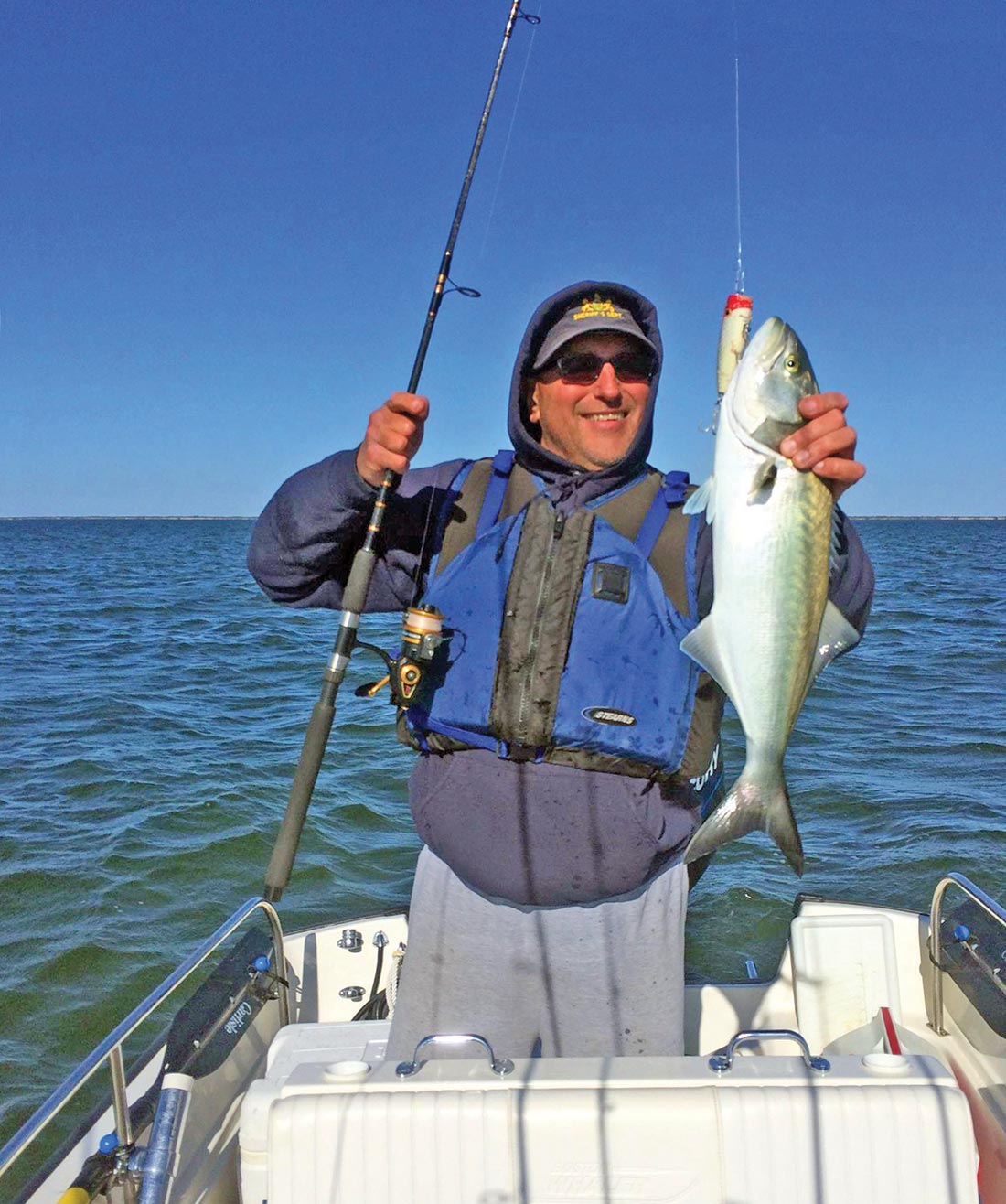
Anglers with a little salt crust on their caps can recount at least a couple of bluefish blitzes. Maybe it’s an eruption right under your feet, or some distant bird action, but when you’re there in the center of it all, it’s Mother Nature at her savage best. Pound for pound, bluefish feed and fight with more attitude than any other fish that swim off our coast. Pelagic, fearless, cannibalistic, gluttonous, toothsome, and even dangerous to those who don’t know better and permit digits to get within biting range of their impressive teeth. While blues of any size are worthy fighters, the bigger they are, the badder they are, making them a fan favorite.
Fortunately, bluefish can be found in our region from spring through fall. Boaters can troll bucktails, tubes or plugs for springtime racers – long and lean blues – working their way inshore from their offshore wintering grounds. Some years, these blues will enter our inlets, bays and estuaries, creating fast paced action for boaters and shore fishermen alike. That’s where topwater plugs come into their own, as the blues will savagely attack most any surface offering.
Anglers targeting striped bass during their spring and fall migrations will also benefit from the blues’ more predictable and cooperative feeding habits. Some years bluefish not only invade our inlets, bays and rivers, they will also set up residence well into the summer months. These are typically bay-size, Taylor blues averaging 3 to 5 pounds. “Good eating size” is the usual comment accompanying these yellow-eyed, silvery green beauties. To me, they symbolize summer inshore fishing at its finest.
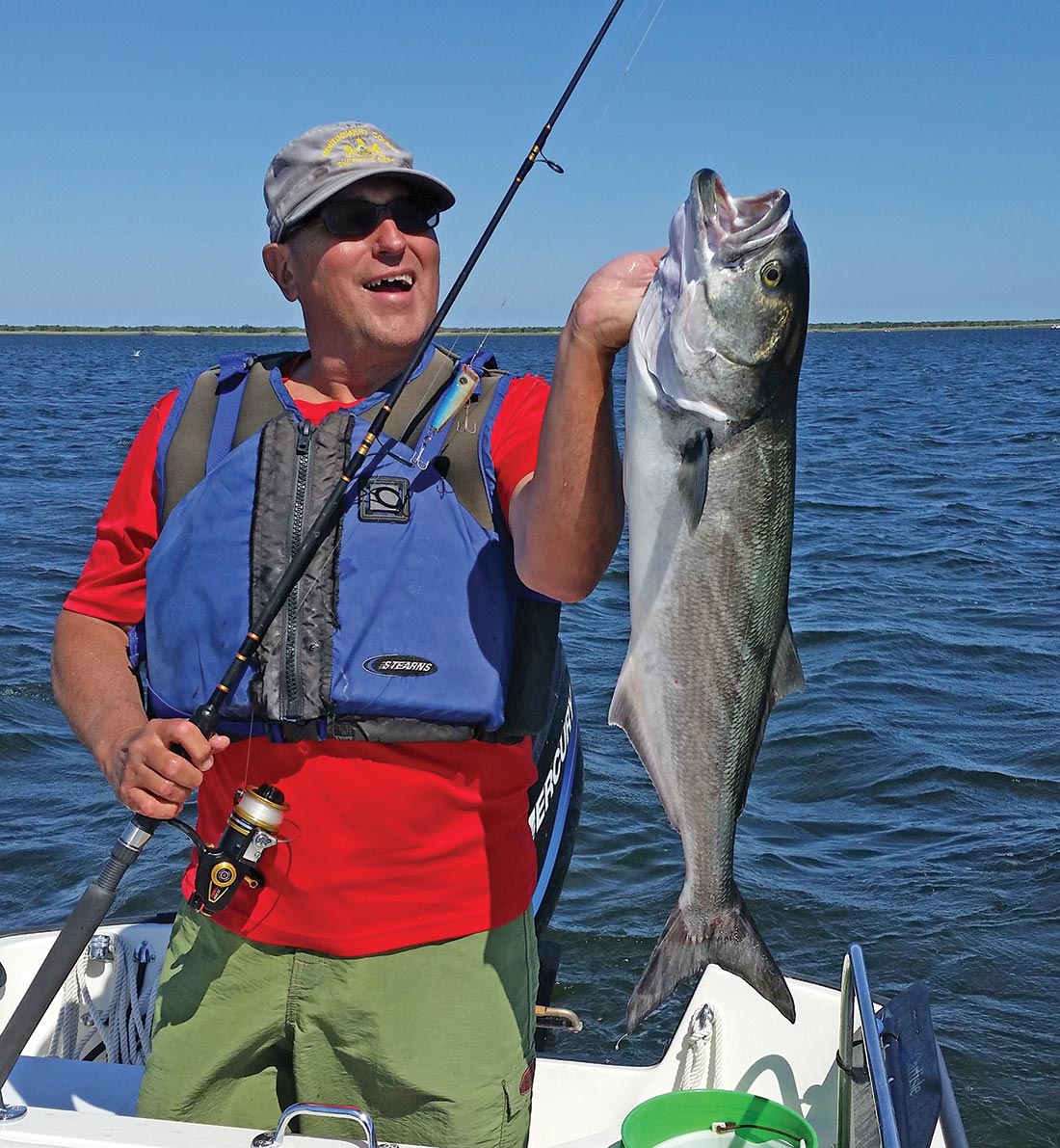
Last year, cocktail blues dominated the late summer, early fall action across much of our region, while big blues were a rare commodity of most anglers. These were smaller 1- to 3-pound fish that provided lots of fun for those anglers who scaled down their gear to light spinning outfits. Catching them was a blast and their size was perfect for the dinner table. Anyone who questions the eating quality of these small blues is doing something wrong. Bleed them when caught, get them in the cooler, fillet them and be sure to remove every bit of red meat (should be minimal if you have bled them), and fry them up fresh. I promise you will become a believer.
Some falls, heavy-shouldered slammer blues migrating south with the stripers, and fattening themselves up on an abundance of bunker, will wreak havoc on tackle. These silvery, purple-hued alligators will test you and your tackle, but are often too oily for most palates. They are however, excellent candidates for the smoker. No one can dispute the blues’ qualities as the ultimate brawler, with a nasty, never-say-die spirit, but conventional attitude rates them as only so-so on the dinner plate. I’ll counter those views with a paraphrase from Will Rogers who stated “I never met a bluefish I didn’t like.” Catch and release fishing for bluefish continues to grow and gain support, and that’s a good thing, especially given this season’s three fish bag limit. Take only what you can use and help ensure a brighter future for the fishery.

Like Santiago in the Old Man and The Sea, we are bound to love and respect our quarry. Let’s practice gentle releases when choosing to do so, and let’s treat the fish we take to eat with care and respect. Killing the fish quickly, bleeding it out and icing it down will go a long way in preserving the distinctive – and to me, desirable – flavor of bluefish. Recipes for bluefish are as boundless as the internet and your imagination. Filets cut into strips and pan-fried (bluefish fingers), barbecued in foil, marinated on the grill, oven baked, or boiled and used in place of crab meat in your favorite crab cake recipe, bluefish filets are as versatile as they are flavorful. Two of my favorite ways are smoked and blackened. I’ve even made teriyaki flavored jerky from thin-sliced snapper filets. My latest venture is bluefish sashimi – flash freeze tender filets of young-of-the-year bluefish, cut in pencil-thin strips, and added as the main ingredient to our sushi rolls. Very labor intensive, but the results sure are good!
I’ve always liked catching bluefish, from when I was a 12-year-old, snapper fishing on the dock of the bay, and singing that Otis Redding song, to hooking a monster slammer while trolling an offshore lump. So bring on the blues. I’ll appreciate them even more in light of our new regulations. Somewhere along the line I’ll be playing the blues and loving it!

